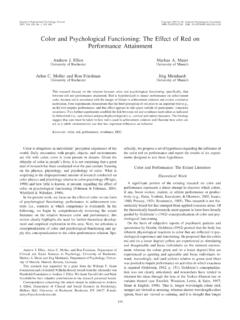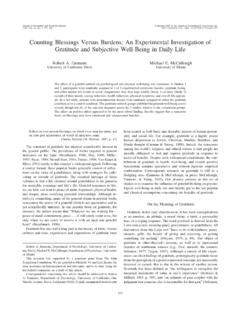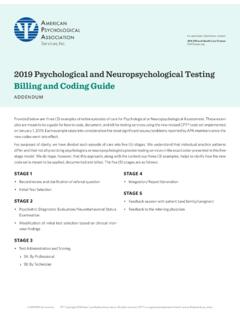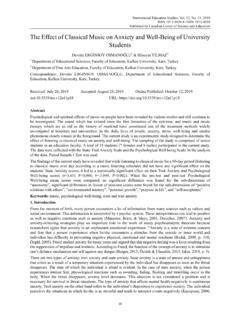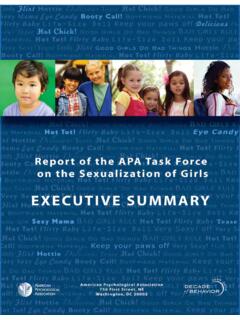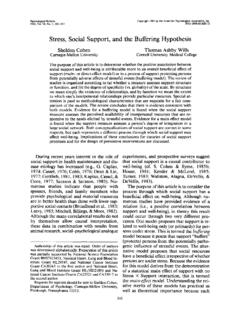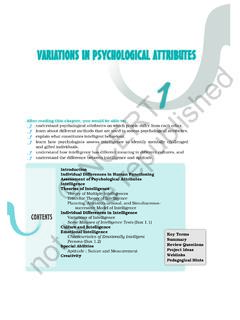Transcription of POVERTY IN EDUCATION
1 POVERTY IN EDUCATION A Literature Review Presented to the Dr. Min Yu Missouri State University In Partial Fulfillment of the Requirements for ELE 711 Master of Science in EDUCATION --Elementary EDUCATION by Sadie Greever April, 2014 2 REVIEW OF THE RELATED LITERATURE The purpose of this literature review is to provide a comprehensive summary of the topic of POVERTY and its effects upon student behavior and academic performance. Presented in this chapter of the review of the related literature will be: (a) description of POVERTY and the role of EDUCATION , (b) effects of POVERTY on student behavior, (c) effects of POVERTY on student performance, (d) pedagogical implications for teachers of students in POVERTY , and (e) summary.
2 Description of POVERTY and the Role of EDUCATION POVERTY can best be described as a family of four or more whose average yearly income falls below the federal POVERTY level of $22,050. In order for families to make ends meet research shows that approximately twice the income of the federal POVERTY level is needed. Child POVERTY rates vary across the states, but close to 30% of the population of children in the are living below the federal POVERTY level. This is an increase since 2000. (Wight, Chau, & Aratani, 2010) The impact of POVERTY upon EDUCATION is significant. The role of the educator has increasingly changed as research shows that students in POVERTY are less receptive to traditional teaching methods.
3 In response, frameworks for understanding students in POVERTY have been created and embraced by school districts all over the country. Ruby Payne has been one such developer and has described POVERTY as a culture in which specific rules are set in place. She has suggested that educational institutions operate from a middle-class set of norms and fail to communicate to students in POVERTY through ways in which they understand. Her work has been highly critiqued and viewed by some as stereotypical and bigoted; having no valid research to confirm her claims. (Bohn, 2006) 3 Other research has suggested that those in POVERTY have been denied their basic human rights and it is the role of the educational institution to raise awareness and free them from this violation.
4 (Dhillon, 2010) The Universal Declaration of Human Rights (Malik, et al., 1948) has stated as follows: Now, therefore the general assembly proclaims this universal declaration of human rights as a common standard of achievement for all peoples and all nations, to the end that every individual and every organ of society, keeping this Declaration constantly in mind, shall strive by teaching and EDUCATION to promote respect for these rights and freedoms and by progressive measures, national and international, to secure their universal and effective recognition and observance, both among the peoples of Member States themselves and among the peoples of territories under their jurisdiction.
5 (par. 8) Educational institutions in areas of high POVERTY have tried to meet the needs of their students by establishing programs that attend to their basic needs in order to establish an environment for successful learning to take place. (Wilson, 2012) Effects of POVERTY on Student Behavior Wadsworth and Achenbach have suggested (as cited in Wadsworth, Raviv, Reinhard, Wolff, Santiago, & Einhorn, 2008) that students having grown up living in persistent POVERTY will suffer detrimentally in their physical, psychological, and educational health. Low achievement in schools due to factors such as POVERTY has been linked as an indicator to crime and violence among adolescents.
6 There are many stressors POVERTY creates such as economic strain, family conflict, frequent moves, transitions, exposure to discrimination, and other traumatic events that can have an adverse effect on students 4 behavior. The POVERTY -related stress students experience can lead to truancy and deviant behavior. In Lipsey and Derzon s meta-analysis (as cited in Pharrington & Lober, 2000) it was found that a major factor contributing to juvenile violence was associated with low socio-economic status and family POVERTY . POVERTY has been linked to psychological behavior problems such as hyperactivity, impulsivity, and attention problems which have led to low achievement in school and crime.
7 (Pharrington & Lober, 2000) Effects of POVERTY on Student Performance POVERTY has an adverse effect on student performance and studies have shown that students in POVERTY are below grade level at much higher rates and that they generally have poor or average grades. These educational deficits provide a serious handicap for students in POVERTY . (Murphy & Tobin, 2011) Jensen has suggested that there are several factors involved that play a part in students performance as follows: health and nutrition, vocabulary, effort, hope-and-growth mind-set, cognition, relationships, and distress. Students in POVERTY are more likely to be exposed to food with little to no nutritional value which effects cognitive functioning which, in turn, has adverse effects on academic achievement.
8 Limited vocabulary also affects academic ability and exposure to language is less likely in low socioeconomic cases. (Pungello, Iruka, Dotterer, Mills-Koonce, & Reznick, 2009) The research of Butterworth, Olesen, and Leach (as cited in Jenson, 2013) has indicated that students failure to achieve academically due to low socioeconomic status is correlated with depressive symptoms. 5 Pedagogical Implications for Teachers of Students in POVERTY The pedagogical implications for teachers of students in POVERTY have been related to the implementation of varied instructional strategies designed to ensure that students are able to efficiently acquire, rehearse, and connect knowledge.
9 Successful instructional principles include frequent review sessions, division of material in small steps, modeling, constant assessment, scaffolding, independent practice, and numerous questions which demand a response from students. (Rosenshine, 2012) Students in POVERTY may have limited access to technology, resources, and required school materials. This deficit must not be overlooked and attention should not be draw to it so as to place even more stress on the students. Enhancing family involvement and focusing on strengths are vital for enhancing the success of students in POVERTY , as well as exposing the students to rigorous curriculum that demands higher order thinking.
10 Research has shown that students exposed to curriculum that is learner-centered are less likely to fall into truancy than those exposed to lower-order instructional strategies. Students in POVERTY who are viewed as having intellectual deficiencies based solely on socioeconomic status are less likely to succeed in school. Unbiased instructional support is necessary in order to enhance the likelihood of increased student performance. (Gorski, 2013) Summary POVERTY is described as families of four or more whose income yearly is below the federal POVERTY level of $22,050. Current research has indicated that approximately 30% of the population of children in the live below this income.










